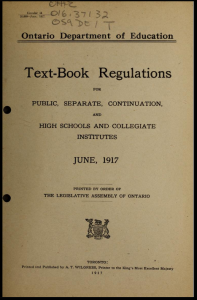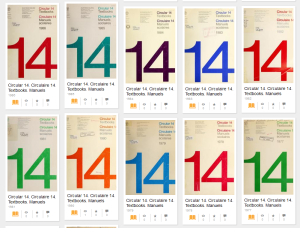The OISE library is excited to announce a key new online resource from the Ontario Historical Education Collection. Our collection of Circular 14, the list of authorized textbooks for the Province of Ontario maintained by the Ontario Department of Education and later the Ministry of Education, is now available online and fully searchable through the Internet Archive. This collection, which runs from 1887 to 1996, is an authoritative primary source and a valuable resource for researching historical education, including educational publishing and policy, as well as curriculum materials evaluation and development.
resource from the Ontario Historical Education Collection. Our collection of Circular 14, the list of authorized textbooks for the Province of Ontario maintained by the Ontario Department of Education and later the Ministry of Education, is now available online and fully searchable through the Internet Archive. This collection, which runs from 1887 to 1996, is an authoritative primary source and a valuable resource for researching historical education, including educational publishing and policy, as well as curriculum materials evaluation and development.
Throughout most of the 20th century, Circular 14 listed the textbooks reviewed and authorized for use in Ontario elementary and secondary classrooms. This authorized textbook list was introduced by Egerton Ryerson in 1846 with the aim of providing textbooks with Canadian content, achieving greater consistency across schools, and managing the costs of textbooks. Prior to being released as Circular 14, this list was included in the Department of Education’s report to the Ontario legislature, and later in the departmental publication Education Journal. Up until 1950, the list included books that had been authorized by the Department through a contractual agreement with the publisher, and were often authored by staff at the Department. As a result of the 1950 Royal Commission on Education in Ontario, the textbook review procedures were adjusted to allow any book to be submitted by a publisher for department approval, and only those approved would be added to the list. This newer system added significantly more books to the list, and provided more freedom of choice to teachers and school boards.
Over its long  run, Circular 14 sometimes met with criticism; teachers and school boards complained of its restrictions and found ways to circumvent it. In the Canadian publishing community, some felt the approval process influenced the textbook market unfairly and authors at times asserted that the Ministry requested overly-conservative edits. Various public interest groups also made claims that many of the approved textbooks contained out-dated or biased representations of race and gender. To address these issues, several research studies and committees were formed throughout the 1960s and 70s in order to critically examine these themes in Ontario textbooks. This work culminated in the 1980 Ministry publication of Race, Religion and Culture in Ontario School Materials: Suggestions for Authors and Publishers to encourage more critically aware learning materials. Circular 14 remained the official textbook list for public education in Ontario well into the 1990s; the final circular was published in 1996. Soon after, the Ministry began transitioning in preparation for the switch to a four year secondary school program, which occurred in 1999. The approved textbook list for Ontario schools is known today as the Trillium List.
run, Circular 14 sometimes met with criticism; teachers and school boards complained of its restrictions and found ways to circumvent it. In the Canadian publishing community, some felt the approval process influenced the textbook market unfairly and authors at times asserted that the Ministry requested overly-conservative edits. Various public interest groups also made claims that many of the approved textbooks contained out-dated or biased representations of race and gender. To address these issues, several research studies and committees were formed throughout the 1960s and 70s in order to critically examine these themes in Ontario textbooks. This work culminated in the 1980 Ministry publication of Race, Religion and Culture in Ontario School Materials: Suggestions for Authors and Publishers to encourage more critically aware learning materials. Circular 14 remained the official textbook list for public education in Ontario well into the 1990s; the final circular was published in 1996. Soon after, the Ministry began transitioning in preparation for the switch to a four year secondary school program, which occurred in 1999. The approved textbook list for Ontario schools is known today as the Trillium List.
As a permanent record of the evolution of learning materials in Ontario, Circular 14 is a unique primary source. Historical researchers have recognized Circular 14 as an incredible lens for studying how a variety of historic, cultural, and political themes were addressed in the educational system. These have included race, gender, French-English relations, the representation of war and peace, the notion of “official” knowledge or histories, multiculturalism, indigenous representation, and the relationship of science to technology. Book and print culture historians have also used Circular 14 as a source for investigations of Canadian publishing history and the economics of educational publishing. There is certainly much more work to be done, and we hope the availability of this valuable online resource will serve the research community well.
References and Further Reading:
Clark, P. & Knights, W. (2011). “Gringo Operations”: Nationalism and Capital in Canadian Educational Publishing, 1970-81. Journal of Canadian Studies/Revue d’études canadiennes 45(2), 123-161. University of Toronto Press.
Clark, P. (2008). “Reckless extravagance and utter incompetence”: George Ross and the Toronto textbook ring, 1883-1907. Papers of the Bibliographical Society of Canada, 46(2), 185-236.
Cook, S. A. (2008). From ‘evil influence’ to social facilitator: Representations of youth smoking, drinking, and citizenship in canadian health textbooks, 1890–1960. Journal of Curriculum Studies, 40(6), 771-802.
Fraser J. (1979) The Circular 14 story: Approved textbooks in Ontario. Orbit 10(4), 8-9
Igartua, J. E.(2008). The Genealogy of Stereotypes: French Canadians in Two English-language Canadian History Textbooks. Journal of Canadian Studies/Revue d’études canadiennes 42(3), 106-132. University of Toronto Press.
Ontario. (1980). Race, religion, and culture in Ontario school materials: Suggestions for authors and publishers. Toronto: Ministry of Education.
Ontario., & Crothers, T. W. (1907). Report of Text Book Commission, 1907. Toronto: Printed by L.K. Cameron, Printer to the King.
Nelson, G. W. C., & Ontario. (1970). A review of all textbooks listed in Circular 14 for the purpose of identifying bias or prejudice towards ethnic groups with particular reference to Indians. Toronto: Ontario Ministry of Education.
Montgomery, K. (2006). Racialized hegemony and nationalist mythologies: Representations of war and peace in high school history textbooks, 1945–2005. Journal of Peace Education, 3(1), 19-37.
Parvin, V. E. (1965). Authorization of textbooks for the schools of Ontario, 1846-1950. Toronto: Published in association with the Canadian Textbook Publishers’ Institute by University of Toronto Press.
Royal Commission on Education in Ontario., & Hope, J. A. (1950). Report. Toronto: Printer to the King.
Royal Commision on Book Publishing (1973). Canadian publishers & Canadian publishing. Toronto: Ministry of the Attorney General.
Yeow, T. C. (2013). Through the “Western” Gaze: Chinese history in Ontario High School World History Syllabus and textbooks, 1947-ca. 1980s. History of Education Review, 42(2), 199-211.
